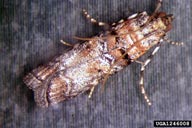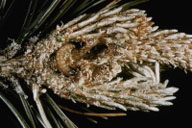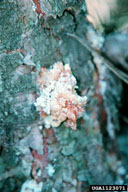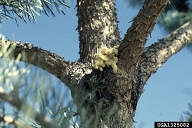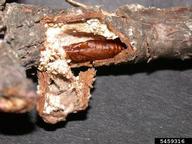Zimmerman pine moth
Dioryctria zimmermani (Grote) (Lepidoptera: Pyralidae)
Orientation to pest
Zimmerman pine moth, Dioryctria zimmermani (Grote), is one member of a group of closely related native North American species that have been poorly distinguished and still await further clarification in some cases. Names in the older literature may be unreliable. Adults of D. zimmermani emerge in mid-summer and lay their eggs in various places on the tree trunk or buds. Larvae upon hatching immediately settle into bark crevices and overwinter in hibernacula. Larvae resume feeding the following spring by tunneling into newly formed terminals or lateral shoots, which become hooked and discolored. Larvae feed on the cambial layer and outer xylem of all common pine species. Feeding sites are distinguished by large masses of accumulated frass and pitch. When mature, larvae leave the terminals and tunnel into the whorl, girdling tips or branches. Pupation takes place in the pitch masses associated with larval feeding.
Hosts commonly attacked
In North America, this moth attacks most common pines, but damage is principally important in Christmas tree plantations of Scotch (Pinus syvestris L.), red (Pinus resinosa Sol. ex Aiton), and Austrian (Pinus nigra J.F. Arnold) pines in the north central United States and southeastern Canada.
Distribution
In North America, this moth occurs in southeastern Canada and the northeastern United States, as far west as Minnesota.
Images of Zimmerman pine moth
| Figure 1. Adult of Zimmerman pine moth, Dioryctria zimmermani | Figure 2. Larva of Zimmerman pine moth |
| Figure 3. Feeding of Zimmerman pine moth larvae results in pitch accumulations on the bark, usually near the branch nodes | Figure 4. Pupal skin of Zimmerman pine moth inside pitch mass (opened) | |
Important biological control agents related to this pest species
Various parasitoids are listed in the literature as attacking this species. But many of these studies predate the clarification of species boundaries in this group and so it is unclear exactly which species these records refer to. Regardless, total parasitism in most studies did not exceeding 5%.
Web links for information on Zimmerman pine moth
- Christmas Tree Fact Sheet | Pennsylvania State University Extension
- Fact Sheet | Pennsylvania State University Extension
- Green Industry Diagnostic Fact Sheet | Cooperative Extension of the University of Wisconsin
Articles
- Yonker, J. W. and D. L. Schuder. 1980. The biology of the Zimmerman pine moth (Dioryctria zimmermani) in Indiana landscapes with reference to its control. Proceedings of the Indiana Academy of Science 89: 207-208.
- Mutuura, A. 1982. American species of Dioryctria (Lepidoptera: Pyralidae). VI. A new species of Dioryctria from eastern Canada and north-eastern United States. The Canadian Entomologist 114: 1069-1076.
